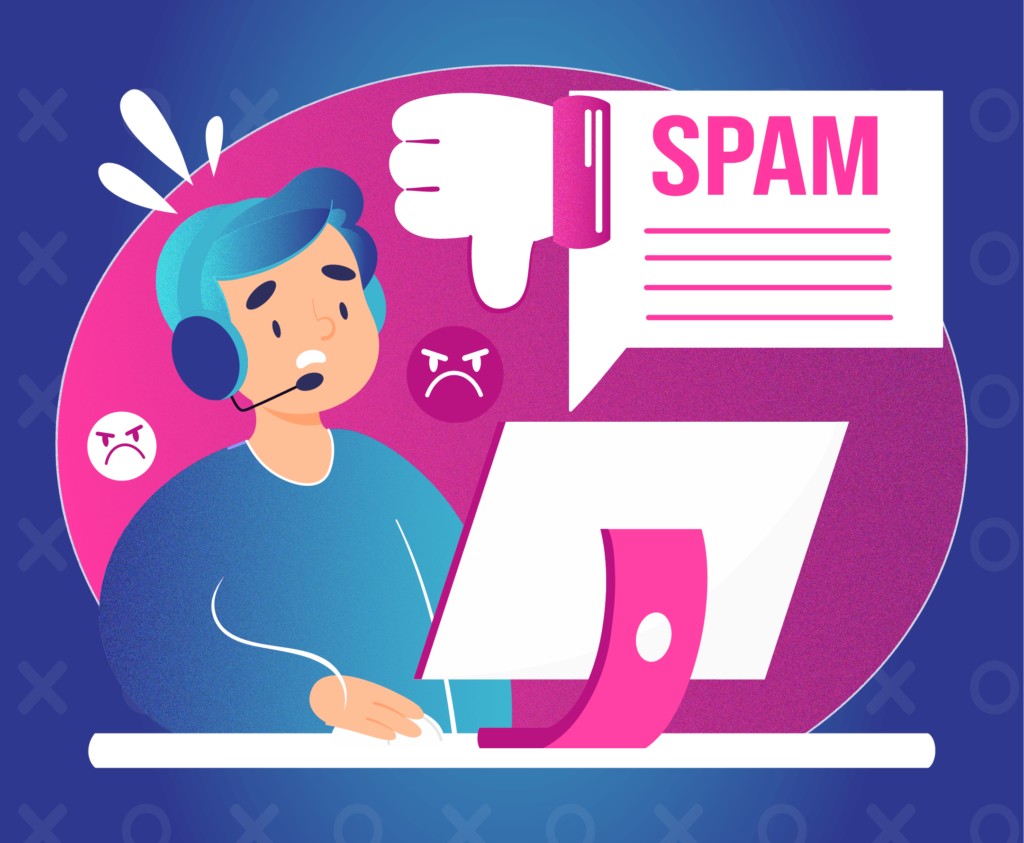Almost one in 10 commercial emails are considered spam by inbox providers.
That’s a big problem.
Estimates for the average cold email response rate vary from 1% – 5% (although we’ve definitely seen campaigns perform a lot better than that). So the last thing you want is to instantly cut a massive chunk from your potential responses by never even hitting the inbox.
That’s why you need to get to know the ins and outs of email spam lists.
In our ultimate email spam lists guide, we’ll explain what spam lists are and how they work. And, of course, we’ll talk through what to do in the unfortunate event that you end up with your name on an email spam list.
Sounds good? Let’s get into it…
What Are Email Spam Lists?
Spam lists — otherwise known as email blacklists — are groups of IP addresses that are believed to send spam messages.
When one of those addresses sends an email, it’ll either end up in the recipient’s spam folder or get blocked completely.
Either way, if you end up on a spam list, your email deliverability will be in the gutter and your chances of running effective email outreach campaigns are massively limited.
Or, to put it another way, if you’re going to do email marketing well, you need to know how to avoid spam lists.
There are actually lots of different email blacklists. To make matters more confusing, each list is unique. Just because an email address is added to one list, that doesn’t mean it’ll be on any of the others.
Importantly, appearing on a blacklist doesn’t mean your future emails have no chance of making it past the spam filter.
Most of the biggest spam lists have specific criteria for blacklisting an IP address, and they’ll typically release servers from email marketing jail after a set period of time (provided no further infringements occur).
What Are the Different Email Spam Lists?

As we’ve already noted, there’s more than one email blacklist. Some are bigger and more important than others, with each email provider having its own preferred list.
Some of the best-known and most credible spam lists are:
- Spamhaus
- Barracuda
- Spamcop
- Invaluement
- Lashback
- Passive Spam Block List (PSBL)
How to Check If You Are On Any Spam Lists
Okay, so we know the names of the biggest spam lists. But, more importantly, how do you find out if your IP address has been blacklisted?
Fortunately, it’s pretty simple to establish using a tool like MX Toolbox’s Blacklist Check. Just enter your server IP or domain and it’ll do the work for you.
How Do Senders End Up On Email Spam Lists?

Sadly, spam filters have never been harder to avoid.
There are any number of actions that could lead to your sender IP address languishing on an email blacklist.
While taking these actions doesn’t 100% guarantee a one-way trip to an email spam list, if you do end up on a blacklist, it could be down to one of these reasons:
Sending High Quantities of Mail
Email servers that send high volumes of mail are more likely to attract attention from spam filters.
Unfortunately, there’s no hard-and-fast rule for what counts as a “high volume” of emails.
Numbers vary for different email service providers, ranging from 100 – 500 a day for a free Gmail account to literally thousands per day with a premium service.
Another key point: watch out for spikes in activity.
If your sender email address barely sends a single message, then suddenly sends 300 emails in an hour, that’s going to look suspicious. And suspicious-looking activity is liable to trigger a bunch of spam notifications.
Forwarding Spam Emails
This is an annoying one.
If your server forwards spam to one or more other email servers, you end up looking like the perpetrator.
In short, be careful what the email accounts on your server forward if you want to stay off spam lists.
Adding Attachments to Cold Emails
It’s baffling that anyone would even consider adding an attachment to an email campaign in this day and age, yet we still see it all the time.
People are rightly suspicious of attachments. They’re one of the most common means of targeting people with malware attacks. So if you’re routinely adding attachments to emails, don’t be surprised to find your messages in the junk email folder.
Racking Up a High Bounce Rate
In the world of email outreach, your email bounce rate is the percentage of email addresses to which your campaign couldn’t be delivered.
Unsurprisingly, if you record a high number of bounces from a single delivery, spam filters take that as a sign that your email list hasn’t been acquired entirely legitimately.
While there are no clear-cut acceptable thresholds for bounce rates, try to aim for beneath the 2% mark.
Including Too Many Graphics In Emails
You might think all those flashy images, gifs, and animations are making your emails more eye-catching and engaging.
Sadly, email spam filters aren’t the biggest fan. Even totally legitimate email campaigns that are packed with graphics are at risk of being blacklisted.
Not Practicing Proper Email List Management
This one ties in with our earlier point about high email bounce rates.
Before you launch a new campaign, try to ensure every recipient email address is correct.
A typo or two might not seem like a big deal, but each misspelling leads to a bounced email — and email bounces catch the eye of the junk email filter.
Falling Into a Spam Trap
Buying a list of email addresses sounds like a simple way to do email outreach at scale.
Purchase a list, write an email, hit Send, and wait for the leads to come pouring in. Easy, right?
But there’s a glaring problem. That third-party email address list you’ve bought might contain one or more spam traps — that is, unpublished email addresses that could only have been gathered through bulk email harvesting or website scraping.
Send a cold email to one of those addresses and BAM, you’ve been blacklisted.
What’s more, some email accounts are set up to assess a company’s process for opt-out requests.
When someone hits your unsubscribe link, it’s your job to remove them from your email list. Fail to honor opt-out requests and… well, you can guess.
Receiving Spam Complaints
If people make spam complaints about the emails you’re sending, you’ll be added to a blacklist sooner than you can say “Hi, {first.name}”.
Problem is, many people don’t distinguish between unsubscribing from mailing lists and flagging an email as spam. But the consequences of spam complaints are much worse than a single person clicking the unsubscribe button.
Still, you should be able to minimize this problem by simply writing better, more relevant emails.
In fact, OptinMonster research shows that two-thirds of recipients flag emails as spam based solely on the subject line. So a great email subject should mean far fewer spam complaints.
How to Remove Your IP Address From a Blacklist

Okay, so you’ve ended up on an email spam list.
That’s a shame — and it’s definitely a sign you need to switch up your email outreach (for more on this, check out our ultimate guide to email deliverability).
But it’s not the end of the world, because there are practical steps you can take to extract your IP from those pesky blacklists and avoid the spam folder once and for all.
Your first port of call should be to check for viruses and dodgy-looking email addresses.
Once you’ve done that, you can run an IP blacklist report to see which spam lists you’ve been added to.
Armed with a full list, you can go through each in turn and try to get your address removed. Here’s what the process looks like for the top six IP blacklists we mentioned earlier:
Spamhaus
Spamhaus operates multiple email spam lists, each with its own removal process.
Paste your IP address into the Domain and IP Reputation Checker to find out which list you’re on (and how to remove yourself from it).
Barracuda
Spam list removals from Barracuda are made via the ominously titled Central Reputation System.
You’ll need a few details — your IP address, email address, phone number, and reason for removal — to send your request.
Once you’ve done that, Barracuda typically investigates and processes the request within 12 hours.
Spamcop
Spamcop automatically handles the thorny issues of blocking and unblocking IP addresses.
In other words, as long as it continues to receive spam complaints about you, your blacklisted status isn’t going anywhere.
But if no new spam reports are made within a 24-hour period, you’ll be automatically removed with no action on your part.
Invaluement
Invaluement claims to specialize in blocking the largest proportion of elusive spam emails without inadvertently targeting legitimate email campaigns.
To extricate yourself from its blacklist, you need to make a delist request demonstrating that your IP hasn’t been used to send spam, or prove that you ended up on the list because your account was hacked.
Lashback
The Lashback spam list is based solely on spam trap addresses.
Because the Lashback team are reasonable folks, you get one consequence-free slip-up every 30 days.
But if you’re a repeat offender, you’ll need to pay to clear your negative reputation.
PSBL
Like Lashback, PSBL bases its blacklist on spam traps.
Its system is entirely passive, which means address removal is pretty simple. Even if you don’t lodge a removal request, your IP will be automatically removed from PSBL’s spam list after a few weeks — provided you don’t fall foul of any other spam traps, that is.
Conclusion
Spam lists are, unfortunately, a fact of life for cold outreach professionals.
You could be doing high-quality prospecting, personalizing your email copy, and sending genuinely valuable content. Yet you might still inadvertently trigger a spam trap, see a spike in your email bounce rate, or accidentally fail to remove an unsubscribed address from your email list.
Hey presto! You’re on a bunch of blacklists and suddenly no one’s receiving your emails.
The important thing is to recognize the types of activity that might land you on email spam lists in the first place and do everything in your power to avoid it.
FAQs
Spam lists exist to protect email users. While a lot of spam is simply annoying rather than malicious, some spammers sell low-quality products, make false promises, and are actively trying to rip people off. Clearly, email service providers don’t want that to happen.
When an email address is blacklisted, it winds up on a database. Email service providers check that database to decide which emails are “legitimate” and which should be flagged as junk mail.
The biggest and most important email spam lists are:
- Spamhaus
- Barracuda
- Spamcop
- Invaluement
- Lashback
- Passive Spam Block List (PSBL)
If your IP has been blacklisted, you’ll need to visit the website of the blacklist operator and copy-paste your IP address. Most spam lists will give you a general reason why you’ve been added, plus instructions for removal.
The most common reasons for emails to be added to spam lists include:
- Triggering an email spam trap
- Failure to practice proper email list management
- Sending very high quantities of email within a set period
- Having your emails flagged as spam by recipients
- Adding attachments to your email campaigns
Free 14-Day Trial
Start building relationships now with your fully-featured 14-day trial!
How We Compare
Terms | Done-For-You Terms | Privacy | Write For Us | Press
© 2025 Postaga. All Rights Reserved. Made with 
